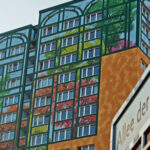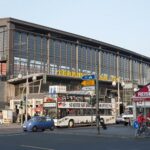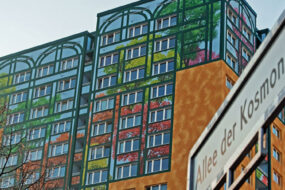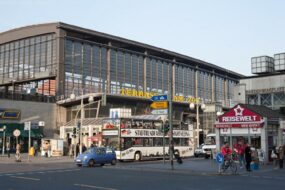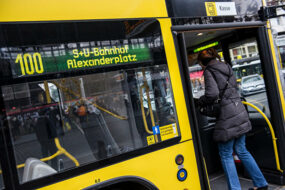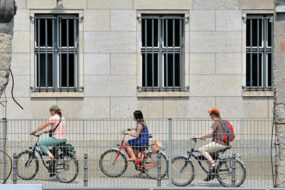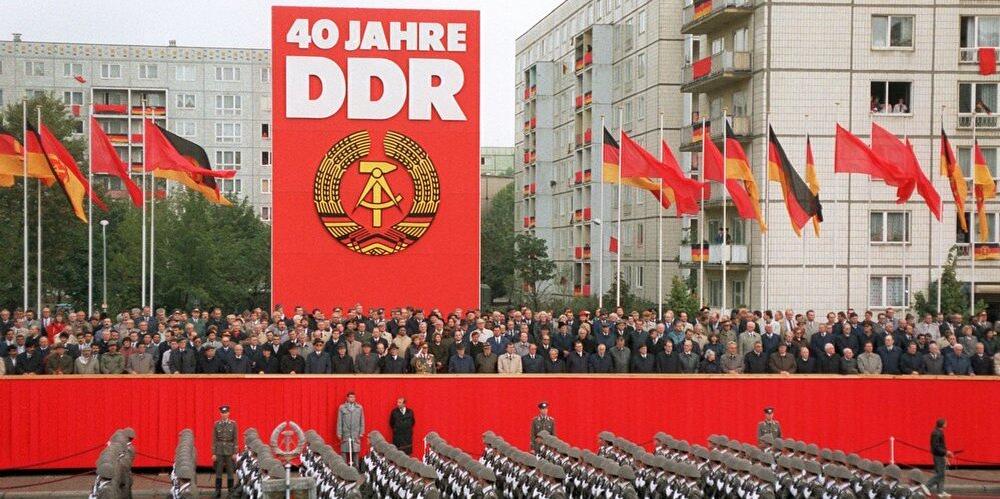
Berlin still bears the marks of its socialist past, and this walking tour takes you on a journey through the heart of the former German Democratic Republic (GDR). Covering 16 stops, the tour leads you along Karl-Marx-Allee, the longest monument of Stalinist neoclassical architecture, past iconic locations like Alexanderplatz and the Berlin TV Tower.
Starting Point: Magdalenenstraße Subway Station
The tour begins at the Magdalenenstraße subway station in the Lichtenberg district. From here, you will head down Frankfurter Allee, facing towards the TV Tower, on a route that spans approximately five kilometers to Alexanderplatz. If you wish to shorten the tour, you can easily hop on the subway at any point along the way.
Stop 1: Former Ministry of the Interior of the GDR and Stasi Headquarters
Just 100 meters from the starting point, turn right into Ruschestraße. At number 103, you will find the former Ministry of the Interior of the GDR, which also housed the Stasi (State Security) Headquarters. Now a museum and memorial site, it features a collection of photographs, documents, and surveillance equipment used by the Stasi to monitor GDR citizens. A highlight of the visit is the office of former Stasi chief Erich Mielke.
Stop 2: Frankfurter Tor
Returning to Frankfurter Allee, the route continues to Frankfurter Tor, where two tower skyscrapers, resembling an artificial city gate, dominate the skyline. The towers’ domes are modeled after those of the German and French cathedrals on Gendarmenmarkt.
Stop 3: Kosmos Cinema
Further along, you’ll spot the Kosmos Cinema, a flat building on the right that stands out from the surrounding architecture. Once the largest cinema in the GDR and a premiere cinema until 1989, it now serves as an event center for conferences.
Stop 4: Karl-Marx-Allee
From here, you get a view of Karl-Marx-Allee, the former grand boulevard of the GDR, which is up to 90 meters wide. The avenue was designed for government parades and marches and is lined with monumental buildings constructed in the Stalinist neoclassical style of the 1950s. Originally named Große Frankfurter Straße, it was renamed Stalinallee in 1949 and later Karl-Marx-Allee in 1961.
Stop 5: Karl Marx Bookstore & Café Sybille
Continue walking until you find the Karl Marx Bookstore, a location featured in German films such as “Good Bye Lenin” and “The Lives of Others.” Nearby is Café Sybille, which retains its GDR charm and hosts an exhibition about the history of “Stalinallee.”
Stop 6: Strausberger Platz
Strausberger Platz, just 300 meters away, is flanked by two 14-story towers known as the “House of the Child” and “House Berlin.” The square was also a key site during the workers’ strike that sparked the 1953 uprising against the GDR government.
Stop 7: Mokka Milk Bar & Kino International
A little further along, you’ll find the former Mokka Milk Bar, a popular 1980s hangout, and next to it, the Kino International. This cinema, with its striking glass front, was another premiere venue until 1989 and now hosts various events as “Klub International.”
Stop 8: Café Moskau
Across the street is Café Moskau, one of seven nationality restaurants in the GDR. The building, a listed structure, features a full-sized Sputnik gifted by the USSR ambassador.
Stop 9: Prefabricated Buildings on Karl-Marx-Allee
Between Strausberger Platz and Alexanderplatz, the architecture transitions to prefabricated buildings constructed in the style of “caught-up modernism.” This stretch also hosted the grandstands for the GDR’s military parades, the last of which was in 1989.
Stop 10: Haus des Lehrers
Approaching Alexanderplatz, you’ll see the Haus des Lehrers (“House of the Teacher”), a 12-story building encircled by a colorful frieze depicting life in the GDR. Built between 1962 and 1964, it served as a meeting place for educators.
Stop 11: Haus des Reisens
Diagonally opposite stands the Haus des Reisens (“House of Travel”), a 65-meter-high building that once housed the GDR’s travel agency and airline, Interflug.
Stop 12: Haus der Elektroindustrie
Behind the Haus des Reisens stretches the 220-meter-long Haus der Elektroindustrie (“House of the Electrical Industry”), which housed the GDR’s Ministry of Electrical Engineering and Electronics. Its facade now features a quote from Alfred Döblin’s “Berlin Alexanderplatz.”
Stop 13: Alexanderhaus and Berolinahaus
Upon reaching Alexanderplatz, you’ll encounter the Alexanderhaus and Berolinahaus, two of the square’s oldest buildings, completed in 1932 and used as a department store and administrative offices during the GDR era.
Stop 14: World Clock
Nearby is the iconic World Clock, installed in 1969, which displays all 24 time zones and has a simplified model of the solar system above it.
Stop 15: Alexanderplatz
In the center of Alexanderplatz is the colorful Brunnen der Völkerfreundschaft (“Fountain of Friendship between Peoples”), built in 1970. Behind it stands the former Centrum department store, the largest in the GDR.
Stop 16: Hotel Park Inn Berlin
The Hotel Park Inn, built between 1967 and 1970, is the tallest building on Alexanderplatz after the TV Tower. Once called “Interhotel,” it hosted delegations from socialist countries.
Stop 17: TV Tower
The final stop, the Berlin TV Tower, is the tallest structure in Berlin at 368 meters. Built in the 1960s, it features a panoramic floor and a rotating restaurant, providing a fitting end to your exploration of Berlin’s GDR heritage.
This walking tour offers a unique glimpse into Berlin’s socialist past, highlighting the architecture and history that still shape the city’s landscape today.
